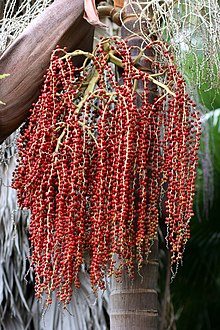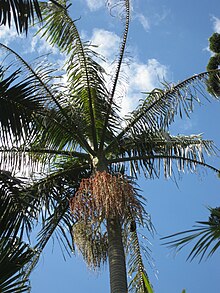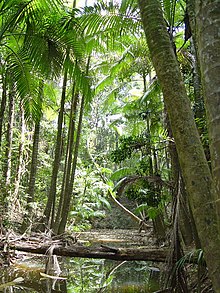Archontophoenix
| Archontophoenix | ||||||||||||
|---|---|---|---|---|---|---|---|---|---|---|---|---|

|
||||||||||||
| Systematics | ||||||||||||
|
||||||||||||
| Scientific name | ||||||||||||
| Archontophoenix | ||||||||||||
| H. Wendl. & Drude |
Archontophoenix is a genus in the subfamily Arecoideae within the family of the palm family (Arecaceae). The six species are only found in the eastern part of Australia. The German common name "Herrscherpalmen", which isoccasionally used,is a translation of the botanical name Archontophoenix .
description


Vegetative characteristics
Archontophoenix species grow as upright, single-stemmed palms. Depending on the species, they can reach heights of between 20 and 30 meters. Their trunk is slender, often with a swollen trunk base and, depending on the species, with prominent stigmas of the fallen leaves or without them.
The leaves are divided into leaf sheath, mostly petiole and leaf blade. The leaf sheaths are tubular and form a corolla of green, brown or purple in color, which ultimately tears open opposite to the petiole. The petiole reaches different lengths depending on the species and can also be missing. The leaf blade is pinnate in pairs with a long rhachis and reduplikat, i. H. split along the edges on the underside of the leaf. The almost opposite leaflets sitting in one plane are linear and pointed. The underside of the leaves is either green or densely covered with scales and then silver-gray.
Generative characteristics
Archontophoenix species are pleonanth (i.e. multiple flowering) and single sexed ( monoecious ). The inflorescence stem is short and strong. The inflorescence is enveloped by two bracts . In the upright to pendulous, three- to four-fold branched, panicle inflorescences , the branches are zigzag-shaped. They bloom pre-male (protandric). Each female flower is bordered by two male flowers on the side, but sometimes the male flowers are only located in the outer section of the inflorescence.
The sitting, unisexual flowers are purple to lavender or whitish to light green, depending on the species. The male flowers have three overlapping sepals and three free, much longer petals as well as 9 to 35 stamens , a rudimentary , sterile pistil in the center of about the same length. The female flowers are significantly smaller with three overlapping, equally long petals and sepals, a single, one-chamber carpel with a short style and three stigmas.
The conical, egg-shaped, elliptical or spherical fruits each contain only one seed and are red to pink in color when ripe.
Systematics and occurrence
The genus Archontophoenix was established in 1875 by Hermann Wendland and Oscar Drude . The genus name Archontophoenix is derived from the Greek word ἄρχων árchōn ( Archon ) for ruler, árchontos for leader, official and the palm genus Phoenix . A synonym for Archontophoenix H. Wendl. & Drude is Loroma O.F.Cook .
The genus Archontophoenix belongs to the sub- tribus Archontophoenicinae of the tribe Areceae in the subfamily Arecoideae within the Arecaceae family . Six other genera belong to the Untertribus Archontophoenicinae: Actinokentia , Hedyscepe , Chambeyronia , Kentiopsis , Mackeea and Rhopalostylis . Their types are medium to large palm trees. The leaves are pinnate, the leaflets with entire margins. The crown shaft is always well developed. The inflorescences are branched two to three times. The cover leaf and bract on the inflorescence stem are similar. The gynoeceum is pseudomonomer. The distribution areas of their species are limited to New Guinea, Australia and New Caledonia.
There have been around six species of Archontophoenix since 1994 , indigenous only to the eastern part of Australia:
- Archontophoenix alexandrae (F. Muell.) H. Wendl. & Drude : This endemic thrives in swamps and rainforests with high levels ofprecipitation, as well as gallery forests along watercourses, only in western Queensland . This fast-growing palm is sometimes also called the fire palm, Alexander palm or royal palm.
- Archontophoenix cunninghamiana (H. Wendl.) H. Wendl. & Drude : It occurs in New South Wales and Queensland.
- Archontophoenix maxima Dowe : This rare endemic thrives in the rainforest of the western Atherton Tablelands at altitudes of 800 to 1200 meters.
- Archontophoenix myolensis Dowe : This very rare endemic occurs only in the Warrill Creek valley (tributary of the Bremer River ) west of Kuranda in Queensland. There are fewer than 100 known specimens in the natural habitat .
- Archontophoenix purpurea Hodel & Dowe : This endemic thrives only on the granite massifs of Mount Spurgeon , Mount Lewis and Mount Finnigan at altitudes of 400 to 1200 meters.
- Archontophoenix tuckeri Dowe : This endemic occurs only on the Cape York Peninsula between the Cape and the McIlwraith Range in Queensland.
Use and occurrence as neophytes
Archontophoenix species, especially Archontophoenix alexandrae and Archontophoenix cunninghamiana , are used as ornamental plants in suitable climatic areas without frost almost worldwide in parks and gardens.
Archontophoenix cunninghamiana is locally feral and naturalized in South America, so close to São Paulo , Brazil. Archontophoenix alexandrae rarely feral, it has been observed as a neophyte in Hawaii .
Web links
Individual evidence
- ↑ a b Helmut Genaust: Etymological dictionary of botanical plant names. Springer-Verlag, 2013. Archontophoenix on p. 73 in the Google book search
- ↑ a b c d John L. Dowe, Donald R. Hödel: A Revision of Archontophoenix H. Wendl . & Drude (Arecaceae). In: Austrobaileya , Volume 4, Issue 2, 1994, pp. 227-244. JSTOR 41738856
- ↑ a b c Rafaël Govaerts (Ed.): Archontophoenix. In: World Checklist of Selected Plant Families (WCSP) - The Board of Trustees of the Royal Botanic Gardens, Kew . Retrieved October 20, 2015.
- ^ Archontophoenix alexandrae - Fire Palm. Retrieved October 16, 2015 .
- ↑ Ricardo Dislich, Nabor Kisser, Vania R. Pivello: A invasão de um fragmento florestal em São Paulo (SP) pela palmeira australiana Archontophoenix cunninghamiana H. Wendl. & Drude. In: Revista Brasileira de Botanica , Volume 25, No. 1, 2002, pp. 55-64.
- ^ Forest Starr, Kim Starr, Lloyd Loope (2003): Archontophoenix alexandrae. In: Hawaiian Ecosystems at Risk project = HEAR, Plants of Hawaii . PDF.



